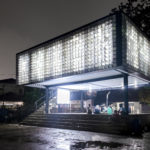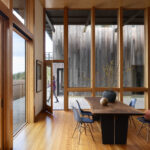The success of the High Line in New York has spawned a new generation of reclaimed-urban-infrastructure-parks. São Paulo, Brazil might be the latest city to find a patch of elevated greenery in the dense metropolitan fabric. The question is, do they reeeally want one?
The answer is looking like a “yes,” given the current status of a piece of highway that would be perfect for a park, Elevado Presidente Costa e Silva. Known as the Minhocão (Big Worm), the intensely unpopular stretch of road hovers above a 2-mile stretch of dense neighborhoods and has a dubious history: Built in 1971 by Mayor Paulo Maluf — who is wanted on international conspiracy charges — it is said that he erected the road to get from his house to work without stop lights. It starts in front of his house, and snakes through the city with no on or off ramps.
Today the Minhocão is only open to traffice from 6:30am to 9:30pm, Monday to Saturday. This leaves the highway vacant for large amounts of time, giving the locals a chance to make it their own. In classic Latin American form, groups of citizens have transformed the off-hours roadway into a vibrant community gathering place. Cars cannot access the DIY park, but pedestrians have no problem, and they host community events from dance parties with boomboxes to barbecues with roll-out sod, plastic chairs, and grills. There are sidewalk chalk artworks and installations by artists, such as Felipe Morozini’s Hanging Gardens of Babylon. A collaborative, Baixo Centro (roughly “Lower Downtown”), have put on more organized events that they call “civil occupation.”

Image via Lets on Flickr
Support for a High Line-style park is growing, but do these residents really know what they are asking for? They want to take this unique, unplanned place that transcends cultural and class lines, and make it into a permanent park that might be scrubbed of much of its street art and unique character, and left in the hands of the city to regulate. Would the makeshift barbecues and dance parties still be allowed? What about other inventive programming?

Image via Rodrigo Vieira on Flickr
A manicured, elevated park is also risky because it could be killed by its own success, much like the High Line, where tourists clog the narrow pathways, making it more like the ever-packed Times Square than a reclaimed urban oasis. But the most important lesson we have learned is that New York’s linear park has become one of the most powerful gentrification engines in the history of cities. It has become a tool for the mayor’s office to further clean up the city and make it a more homogenous, corporatized and high-rent locale that is out of reach for many of the former residents. The Minhocão park is already being used by developers as a sales pitch.
Photo by Bruno Fernandes on Flickr
The irony of making this unique community public space into a High Line is that the reason that the area around the elevated road is so diverse is that many of the wealthier people moved out when the monstrosity was erected. It is important for the residents of São Paolo to realize exactly what these reclaimed spaces are. If top-down expert planning fails to meet bottom-up community activism halfway, they can become lightly-shrouded private spaces, such as different-looking malls. It will be up to the citizens of São Paolo to learn the lesson of the High Line and make sure this place stays a truly public place.

Photo by Marcelo Druck on Flickr)
Photo at top by Christopher Pillitz, via More Intelligent Life
h/t to Next City









